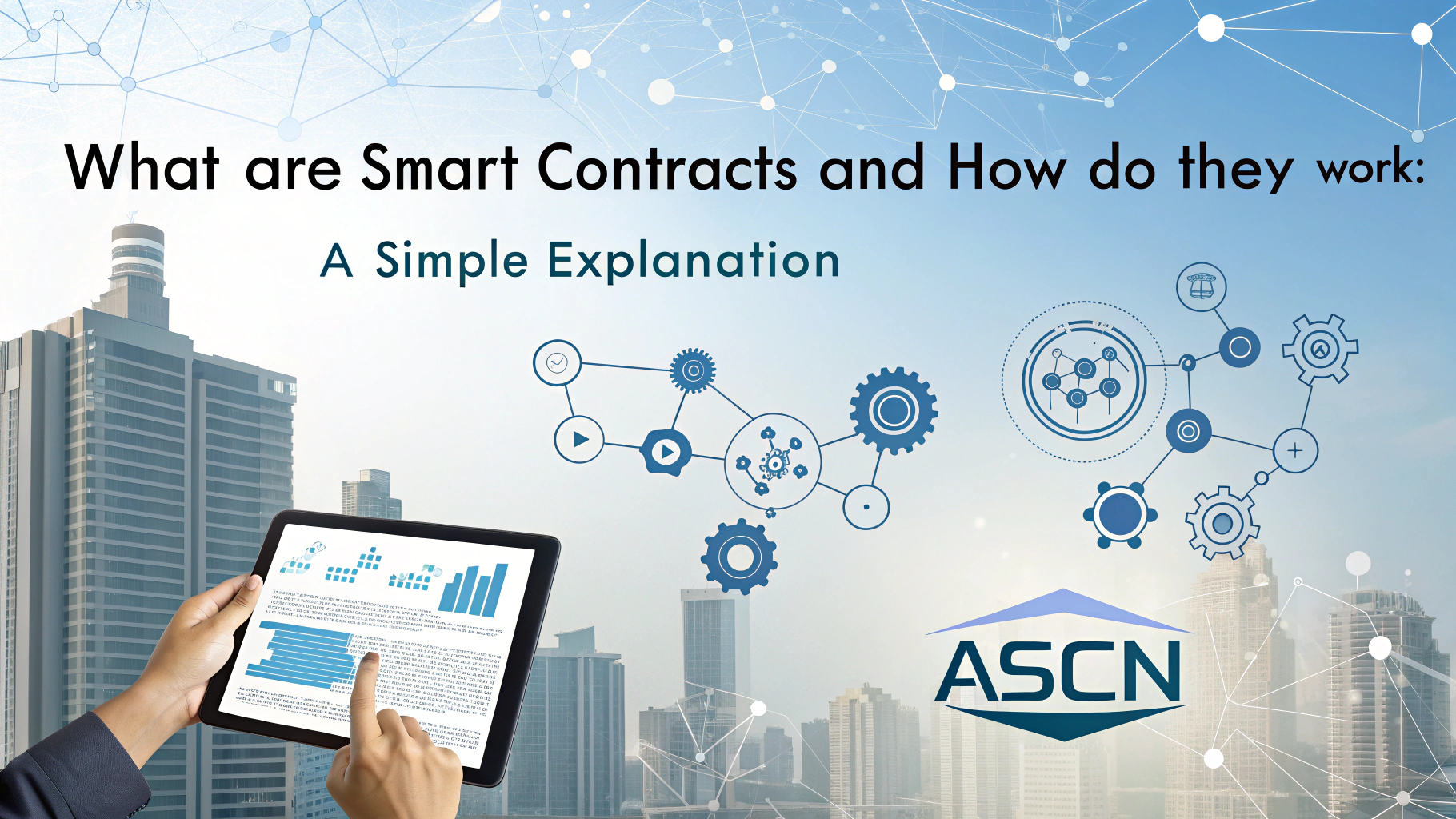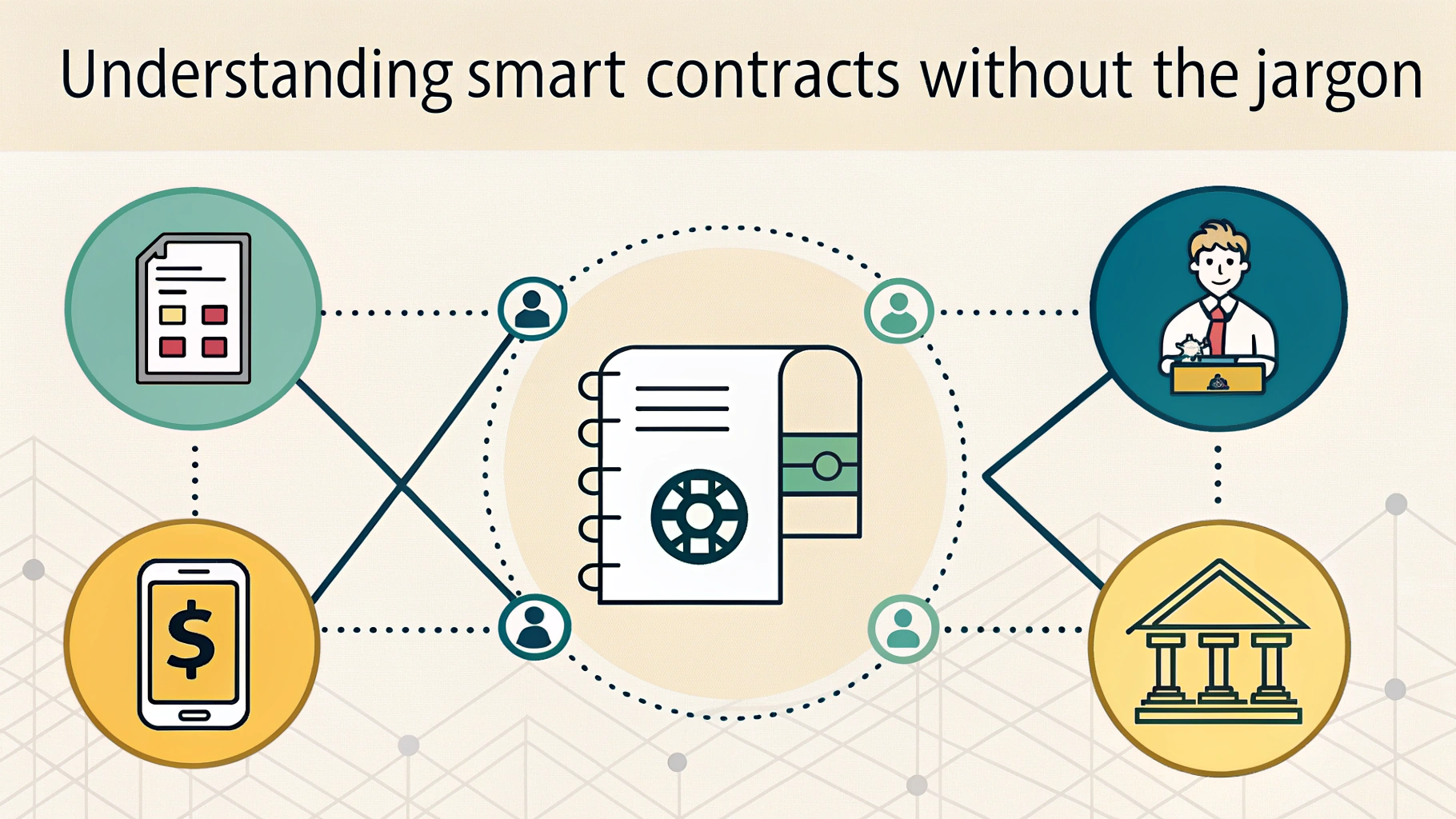What are smart contracts and how do they work: a simple explanation — ASCN

What are smart contracts and how do they work: a simple explanation — ASCN
Have you ever imagined making a deal without lawyers, notaries, or paperwork? No middlemen, no signatures on paper — just pure code and trust. Sounds futuristic? It’s already real.
Smart contracts are changing how we think about finance, ownership, and even law itself. They promise transparency, automation, and — most importantly — trust in a digital world that often lacks it.
Understanding Smart Contracts — Without the Jargon
Let’s start from scratch. No fancy terminology — just the essence.

What it really means
A smart contract is a program that automatically enforces an agreement between parties based on rules written into its code. No “what if” or “maybe later.” Everything is black and white: if the conditions are met, the contract executes.
Here’s what it looks like in practice: imagine you rent online storage. The contract says, “if the user pays 0.01 ETH, grant access.” Pay — you get in. Don’t — you don’t. Simple.
All of this happens on a blockchain — a distributed database that keeps every record forever, making it virtually impossible to alter or fake.
Who Came Up With the Idea?
It might sound like a 21st-century concept, but the idea actually dates back to 1994.
It came from Nick Szabo, an American cryptographer and legal theorist who, long before Bitcoin, proposed “digital agreements” that could execute themselves. Some even suspect Szabo might be Satoshi Nakamoto — though that’s never been proven.
His smart contract concept later became a cornerstone for modern blockchain systems, including Ethereum.
But the real magic started in 2015, when Ethereum made the idea practical. That’s when smart contracts stopped being theory — and became technology.
How They Differ From Regular Contracts
A traditional contract is basically paper. Humans have to enforce it. If someone breaks the deal, you go to court, hire lawyers, and wait — sometimes for months.
A smart contract flips that upside down. It monitors and enforces itself. The code doesn’t wait for permission. It simply executes.
Once it’s deployed, nobody can interfere. No cancellations, no “let’s change that line.” What’s written in the code is the law.
How Smart Contracts Work
Alright, the basics are clear — now let’s dig a little deeper. What makes these digital contracts so reliable?
Blockchain and Decentralization
Smart contracts don’t live on some company’s private server. They exist directly inside the blockchain, replicated across thousands of computers around the world.
That means no one can modify or delete them after launch. No admin, no CEO, no “undo” button.
Every transaction is verified and stored permanently, protected by cryptography and consensus mechanisms.
Here’s an example: suppose you create a contract that pays royalties to an NFT artist after a sale. That contract will work the same way in Tokyo, São Paulo, or Berlin — because it doesn’t live on any single website. It lives on the network itself.
Programming Languages: Solidity, Rust, and Others
Now, what are these contracts actually written in? Developers use specialized languages designed for blockchain environments.
-
Solidity – the main language for Ethereum. It looks a bit like JavaScript but is built specifically for blockchain logic.
-
Rust – used by projects like Solana and Near; it’s fast and secure, ideal for high-performance systems.
-
Vyper – a simplified, safety-first alternative to Solidity.
Each contract follows a simple “if/then” logic.
If the condition is met → execute the action.
If not → nothing happens.
Think of it like Excel formulas — but on steroids.
Example:
If a buyer sends exactly 1 ETH, the NFT is automatically transferred.
No middlemen, no manual confirmations — just code doing its job.
Examples Across Blockchains
Ethereum is still the home base for smart contracts, powering major platforms like:
-
Uniswap — a decentralized token exchange;
-
Aave — lending without banks;
-
OpenSea — the biggest NFT marketplace.
But it’s not alone.
-
Solana offers high speed and low fees;
-
BNB Chain is optimized for mass adoption;
-
Polkadot focuses on connecting multiple blockchains.
Each has its perks, but the principle stays the same — code that executes trustlessly, without intermediaries.
Where Smart Contracts Are Used
Now that the foundation’s clear, let’s move to the real question: where does this actually work in practice?
Because smart contracts aren’t some theoretical gadget for coders. They already power dozens of real-world services and platforms — quietly running behind the scenes.
DeFi: Decentralized Finance
DeFi — short for “decentralized finance” — removes banks and replaces them with code.
No branches, no tellers, no forms. Just smart contracts.
Here’s where they truly shine:
-
Exchanges (DEXs) like Uniswap, Raydium, PancakeSwap. You connect your wallet, choose tokens, hit swap — and the contract instantly executes the trade at the market rate.
-
Lending platforms such as Aave or Compound. You deposit collateral, get a loan, and repay it automatically through code. Once it’s cleared, your collateral is released.
-
Staking through Lido or Rocket Pool. You delegate your tokens, and the contract stakes them, collects rewards, and redistributes them back to you.
By 2025, over $130 billion is locked in DeFi protocols — and that number keeps climbing.
NFTs and Gaming
NFTs turned digital art and collectibles into an entire economy. And at the core of it all — smart contracts.
They define who owns what, what royalties go to the artist, and how each transfer happens.
Here’s how it works:
-
When you mint an NFT, the contract writes ownership and rights into the blockchain.
-
When it’s sold, the code automatically transfers the token and distributes commissions (say, 10% to the creator).
-
In games, contracts handle in-game assets, loot, rewards — turning digital items into real, tradable property.
Thanks to that, your virtual sword or digital artwork isn’t just “data” anymore — it’s an asset you can actually own.
ICOs, DAOs, and Crowdfunding
Traditional crowdfunding works on faith: you send money, and hope the team keeps its word.
Smart contracts cut the “hope” part out completely.
-
In ICOs, tokens are issued only when specific funding goals are reached.
-
In DAOs, votes and results are executed by the code itself.
-
In crowdfunding, funds unlock step by step — only after each milestone is met.
Example: a gaming startup raises 500 ETH. The contract sends tokens to investors and only releases the development funds once the next phase is confirmed. No accountants or gatekeepers needed.
Identity, Logistics, and Insurance
Surprise — smart contracts aren’t just for crypto and finance.
They’re finding their way into:
-
Digital identity — decentralized ID systems managed by users, with access control enforced by contracts.
-
Logistics — every step of a shipment can be logged automatically on-chain, reducing paperwork and fraud.
-
Insurance — payouts trigger automatically once a verified event occurs, like a flight delay or crop loss.
It’s efficiency through code — and it’s spreading fast.
Advantages and Risks of Smart Contracts
Sounds great, right? Automation, transparency, decentralization — all the good stuff.
But let’s not romanticize it. Like any tech, smart contracts bring both power and problems.
Transparency, Security, Automation
Let’s start with the good. Here’s why smart contracts keep winning over the world:
-
Transparency – the code is open; anyone can verify what happens with their funds.
-
Security – contracts live on the blockchain, immutable once deployed — even the creator can’t alter them.
-
Automation – no middlemen, no manual errors; everything runs on predefined logic.
Bugs and Exploits
Now for the not-so-fun part.
Smart contracts are still written by humans, and humans make mistakes.
And those mistakes can cost millions.
Remember The DAO Hack in 2016 ($50 million lost) or the Poly Network breach in 2021 (over $600 million)?
Here’s the brutal truth: if a contract has a bug, you can’t “patch” it after the fact.
Funds can get stuck, lost, or stolen — forever.
That’s why auditing smart contracts has become an entire industry of its own.
Legal and Technical Limits
There’s another layer to this: smart contracts don’t replace law. They only govern what happens on-chain.
Outside of blockchain, things get messy.
What if the contract is hacked?
What if one party is a minor?
What if you need to prove your innocence in court?
In many countries, smart contracts still lack full legal recognition. There are guidelines, but no universal law.
The Future of Smart Contracts — 2025 and Beyond
So, where are we now — and where’s it all going?
By 2025, the landscape looks wildly different. We’re not just talking about basic “if paid → deliver” scripts anymore. The next phase is already taking shape.

Smart Contracts 2.0
The first generation was simple. Now we’re entering Smart Contracts 2.0 — smarter, modular, and able to interact with real-world data.
These contracts can:
-
Pull information from external data sources;
-
React to off-chain conditions;
-
Update or evolve without losing functionality.
Imagine an agricultural insurance contract that checks weather data, soil moisture, and even satellite images before triggering a payout.
That’s where we’re heading — contracts that adapt to real life, not just blockchain events.
Cross-Chain Solutions and Interactive Contracts
Being stuck on one blockchain? That’s yesterday’s news.
In 2025, most serious projects already live on multiple chains — Ethereum, Solana, Avalanche, Arbitrum, zkSync, you name it.
Cross-chain smart contracts make that possible. They can:
-
transfer data and tokens across networks;
-
execute multi-chain logic that covers several blockchains at once;
-
dodge high gas fees when one network gets clogged.
Protocols like LayerZero and Axelar connect these scattered ecosystems, linking contracts into a global Web3 architecture.
And then there’s the next step — interactive contracts.
These can change behavior in real time, reacting to the data they see.
Picture this: a DAO that adjusts its internal voting rules based on how active its members are. No manual governance, no “update proposal.” The contract just evolves as the community does.
AI + Smart Contracts
It might sound like science fiction, but the crossover between artificial intelligence and blockchain is happening right now.
AI tools — think GPT-style models — are already being trained on Solidity and other languages. They’re learning to:
-
generate smart-contract templates;
-
analyze existing code for vulnerabilities;
-
suggest optimized logic based on patterns from thousands of successful deployments.
Of course, it’s early days, but the growth is insane.
Many crypto startups in 2025 already use AI assistants to help draft, audit, or even simulate their contract behavior before going live.
And if you don’t feel like spending hours digging through Etherscan, ASCN.AI can fetch and decode those numbers for you in a few clicks. It’s basically your on-demand blockchain analyst — without the consultant fees.
Regulation and Legal Status
Now, about the law.
Every technology hits this wall sooner or later: innovation runs faster than regulation.
Across the US, Europe, and Asia, lawmakers are working on smart-contract frameworks. They’re trying to define what counts as a legally binding “digital agreement” and how to handle disputes when code goes wrong.
But let’s be honest — the legal system still lags behind.
For now, the real-world legal power of smart contracts is limited, especially when transactions cross borders.
So, yes — the tech is ready. The rules? Still under construction.
Should You Learn Smart Contracts?
At this point, a fair question: is it worth getting into all this?
The answer depends entirely on who you are.

For Developers
If you’re a developer — especially one who’s done web, backend, or mobile — learning smart-contract programming is almost a no-brainer.
It’s the next step for anyone who wants to build economic logic, not just apps.
Start with Solidity or Rust. Try deploying a contract in a testnet. Learn how security audits work.
Right now, in 2025, blockchain engineers are in massive demand — and paid accordingly.
You’re not just coding; you’re shaping how digital economies run.
For Investors
If you invest in DeFi, ICOs, or NFT projects, knowing the basics of smart contracts isn’t just “nice to have” — it’s crucial.
Understanding how these systems operate can save you from serious losses.
Before you click “invest,” take a look at the code or audit report. Use blockchain explorers like Etherscan to see which contracts interact with your funds and whether they’ve been verified.
A little technical literacy here can go a long way — sometimes, it’s the line between profit and disaster.
For Everyday Web3 Users
Even if you’re just a casual Web3 user — buying NFTs, staking tokens, voting in a DAO — knowing how smart contracts work changes everything.
You’ll stop clicking buttons blindly and start understanding what happens underneath.
You’ll see where your funds go, what triggers an action, and how your wallet actually talks to the blockchain.
And who knows — maybe one day you’ll write your own contract that changes the game entirely.
Still have questions after reading all this? Good. That’s normal.
Smart contracts can be fascinating and confusing at the same time.
That’s exactly why ASCN.AI exists.
It’s an AI-powered crypto platform that speaks human, not developer.
No heavy jargon, no endless whitepapers — just clear explanations and real-time insights.
Want to see how a specific DeFi protocol works, check a project before investing, or understand what that mysterious line of code in a contract actually does? ASCN.AI can handle it.
And it’s not just an analyzer — it can also help you build strategies, compare markets, or dig into tokenomics without drowning in data.
Give it a try.
It’s already out there — waiting to make Web3 a little less complicated.


